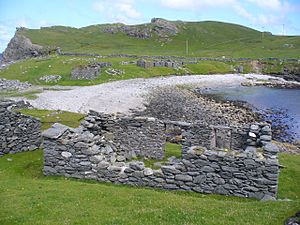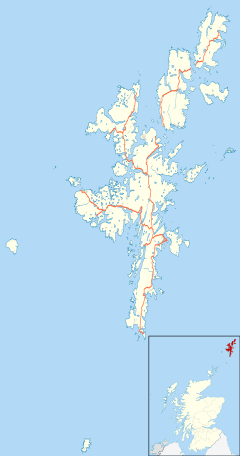Fethaland facts for kids
Quick facts for kids Fethaland |
|
|---|---|
 Ruined fisherman's böds, Fethaland. |
|
| Language | Shetland Dialect |
| OS grid reference | HU373939 |
| • Edinburgh | 330 mi (530 km) SSW |
| • London | 632 mi (1,017 km) S |
| Civil parish | |
| Council area | |
| Lieutenancy area | |
| Country | Scotland |
| Sovereign state | United Kingdom |
| Post town | SHETLAND |
| Postcode district | ZE2 |
| Dialling code | 01806 |
| Police | Northern |
| Fire | Highlands and Islands |
| Ambulance | Scottish |
| EU Parliament | Scotland |
| UK Parliament |
|
| Scottish Parliament |
|
Fethaland, also known as Fedeland, is a place in the very north of Mainland, Shetland. It's an abandoned settlement, meaning people used to live there but don't anymore. This spot was once the biggest Haaf fishing station in Shetland. Fishermen would go out from here to catch fish in the deep sea.
Contents
What Does Fethaland Mean?
The name Fethaland comes from an old language called Old Norse. It means "rich pasture" or "fat land." This suggests the area had good land for animals to graze.
There's a local story about the name. It says that the Picts, an ancient people, were forced to leave Fethaland. As they went out to sea, they supposedly shouted, "Fae da land, fae da land!" (meaning "From the land!"). However, this story is probably not true. The shout sounds like modern Shetland Dialect, which the Picts wouldn't have spoken.
Fethaland's Special Landscape
Fethaland is a very special place in Shetland. It's part of the Shetland National Scenic Area. This means the landscape here is protected because it's so beautiful and important.
The area is also a Site of Special Scientific Interest. This protection is for its unique geology and natural features. It helps to keep the environment safe for wildlife and plants.
A Historic Fishing Station
Fethaland was once a very busy place for fishing. It was home to a large "haaf fishing" station. Haaf fishing was a type of deep-sea fishing. Fishermen would go far out into the ocean in small boats to catch fish.
Tools Used by Fishermen
Fishermen at Fethaland used simple tools. For example, they made oil lamps from large sea snail shells called "buckies" (or Buccinum undatum). These lamps helped them see inside their small huts, called "böds."
One of these shell lamps from Fethaland is now in the Shetland Museum. It was collected by a doctor named Dr. Arthur Mitchell. He studied how people lived and worked in the past.
Protecting the Fishing Station
The Fethaland fishing station is very important for understanding Shetland's history. Because of its historical value, it was officially named a "scheduled monument" on October 10, 1994. This means it's a protected historical site.
In August 2010, experts did a special survey of the fishing station. They even used laser scanning! This was done to check for damage from erosion, which is when the land wears away. The survey helps to make sure this important historical site is preserved for the future.
Images for kids



